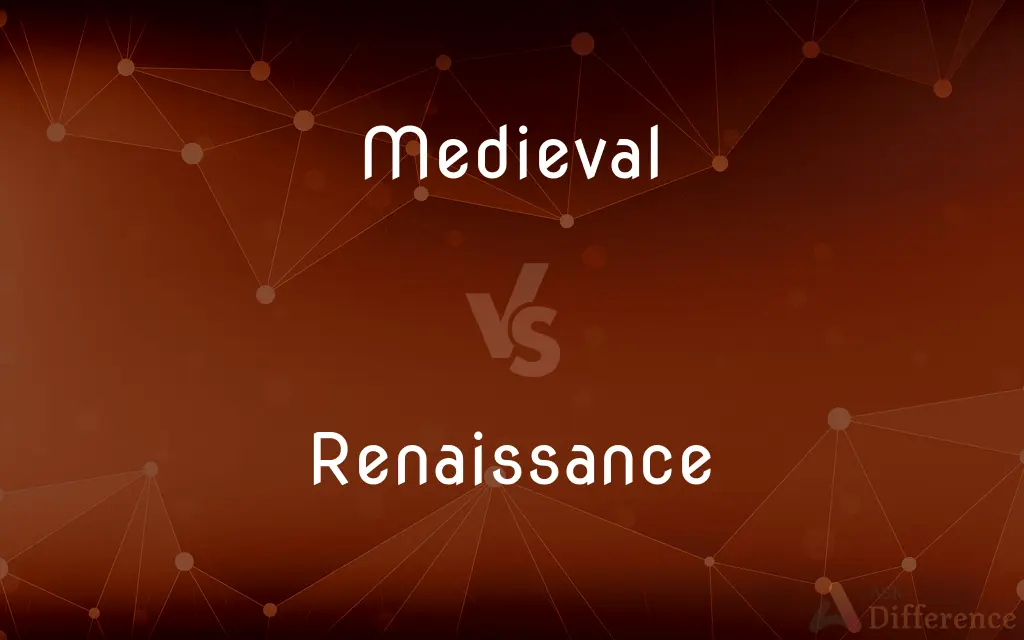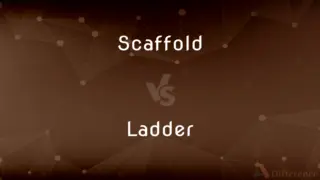Medieval vs. Renaissance — What's the Difference?
By Tayyaba Rehman — Updated on November 6, 2023
Medieval refers to the Middle Ages (~5th to 15th century), characterized by feudalism and the manorial system. Renaissance denotes the cultural rebirth in Europe (~14th to 17th century), focused on humanism and classical learning.

Difference Between Medieval and Renaissance
Table of Contents
ADVERTISEMENT
Key Differences
Medieval times were characterized by a feudal system, where society was structured around relationships derived from the holding of land in exchange for service or labor. Art and architecture during the Medieval period were heavily influenced by religion, with Gothic cathedrals and Christian iconography dominating the landscape.
The Renaissance was a period of renewal and growth that followed the Medieval era, sparking advancements in art, science, and thought. This era saw a shift away from the strictly religious context of the Middle Ages, embracing the rediscovery of classical philosophy, literature, and art. Renaissance art and architecture, epitomized by figures like Leonardo da Vinci and Michelangelo, focused on realism and human emotion.
Medieval society was largely agricultural and centered around the manor, with local lords providing protection in return for service. The intellectual life of the Medieval period was dominated by Scholasticism, which sought to reconcile Christian theology with classical philosophy, primarily that of Aristotle.
In contrast, the Renaissance brought about urbanization and a market economy, encouraging trade and the rise of a merchant class. The intellectual pursuits of the Renaissance embraced a more secular outlook, with a focus on individual achievement and the potential of human beings to shape their own destiny.
Comparison Chart
Time Period
~5th to 15th century
~14th to 17th century
ADVERTISEMENT
Artistic Style
Gothic and religious
Classical and humanistic
Societal Structure
Feudal system
Growth of merchant class
Intellectual Focus
Scholasticism
Humanism
Architectural Focus
Cathedrals, castles
Public spaces, perspective in art
Compare with Definitions
Medieval
Describing the culture or institutions of the Middle Ages
Medieval chivalry is a popular subject of romantic literature.
Renaissance
Pertaining to the period of the Renaissance
Renaissance art is celebrated for its advancement in realism.
Medieval
Characteristic of the styles of the Middle Ages
The medieval architecture is notable for its grandeur.
Renaissance
Describing the revival or renewed interest in something
There's a renaissance in vinyl records among music enthusiasts.
Medieval
Pertaining to the Middle Ages
The medieval castle stood tall for centuries.
Renaissance
Characteristic of the intellectual and artistic activity
Renaissance thinkers placed great value on human potential.
Medieval
Relating to a historical period
Medieval laws were often harsh and unforgiving.
Renaissance
Reflective of the principles or practices of Renaissance culture
The renaissance emphasis on balance and proportion influenced modern design.
Medieval
Relating or belonging to the Middle Ages.
Renaissance
The Renaissance (UK: rin-AY-sənss, US: (listen) REN-ə-sahnss) is a term used to describe a period in European history marking the transition from the Middle Ages to modernity and covering the 15th and 16th centuries. It occurred after the Crisis of the Late Middle Ages and was associated with great social change.
Medieval
Of or relating to a historical period roughly coinciding with the European Middle Ages and characterized by feudal or aristocratic social structures, as in Japan or China.
Renaissance
A rebirth or revival.
Medieval
Suggestive of the Middle Ages, as in being hierarchical or cruel.
Renaissance
The humanistic revival of classical art, architecture, literature, and learning that originated in Italy in the 14th century and later spread throughout Europe.
Medieval
(Informal) Old-fashioned; unenlightened
Parents with a medieval attitude toward dating.
Renaissance
The period of this revival, roughly the 14th through the 16th century, marking the transition from medieval to modern times.
Medieval
Of or relating to the Middle Ages, the period from approximately 500 to 1500 AD.
Renaissance
A revival of intellectual or artistic achievement and vigor:the Celtic Renaissance.
Medieval
Having characteristics associated with the Middle Ages in popular, modern cultural perception:
Renaissance
The period of such a revival.
Medieval
Archaic.
Renaissance
Of, relating to, or characteristic of the Renaissance or its artistic and intellectual works and styles.
Medieval
Brutal.
Renaissance
Of or being the style of architecture and decoration, based on classical models, that originated in Italy in the 14th century and continued throughout Europe up to the end of the 16th century.
Medieval
Someone living in the Middle Ages.
Renaissance
A rebirth or revival.
Medieval
A medieval example (of something aforementioned or understood from context).
Thank God for modern remedies: the medievals were often useless or even harmful.
Renaissance
(historical) Renaissance
Medieval
Same as Mediæval, Mediævalism, etc.
Renaissance
A new birth, or revival.
The Renaissance was rather the last stage of the Middle Ages, emerging from ecclesiastical and feudal despotism, developing what was original in mediæval ideas by the light of classic arts and letters.
Medieval
Relating to or belonging to the Middle Ages;
Medieval scholars
Medieval times
Renaissance
The period of European history at the close of the Middle Ages and the rise of the modern world; a cultural rebirth from the 14th through the middle of the 17th centuries
Medieval
As if belonging to the Middle Ages; old-fashioned and unenlightened;
A medieval attitude toward dating
Renaissance
The revival of learning and culture
Medieval
Characteristic of the time of chivalry and knighthood in the Middle Ages;
Chivalric rites
The knightly years
Renaissance
Relating to the cultural movement
The Renaissance was marked by a surge in classical learning.
Medieval
Reflective of the practices or policies of the Middle Ages
The medieval method of trial by ordeal was abandoned long ago.
Common Curiosities
What sparked the Renaissance?
The Renaissance was sparked by a renewed interest in classical antiquity, humanism, and scientific inquiry.
Did medieval and Renaissance societies coexist?
The Renaissance followed the medieval period, so they did not coexist but are sequential.
Was the Renaissance only about art?
No, the Renaissance also encompassed advances in science, exploration, politics, and literature.
Are the terms medieval and Middle Ages interchangeable?
Yes, medieval is often used to describe anything pertaining to the Middle Ages.
How did the economy differ between the medieval and Renaissance periods?
The medieval economy was agrarian and feudal, while the Renaissance saw the rise of trade and a burgeoning merchant class.
Were medieval times globally homogeneous?
No, there were significant cultural, social, and technological variations across different regions.
What was medieval architecture like?
Medieval architecture includes Romanesque and Gothic styles, featuring castles, fortifications, and churches.
What are some examples of Renaissance achievements?
Renaissance achievements include masterpieces by da Vinci and Michelangelo, and scientific advances by Copernicus and Galileo.
What defines the medieval period?
The medieval period is defined by feudal societies, the manorial system, and predominantly religious art and culture.
Were women's roles the same in the medieval and Renaissance periods?
Women's roles varied, but the Renaissance saw some increased opportunities for women, particularly in the arts and education.
How did warfare differ between the medieval and Renaissance periods?
Warfare evolved from armored knights and castles to include gunpowder weapons and more strategic thinking during the Renaissance.
Did the Renaissance affect all of Europe equally?
The Renaissance began in Italy and spread throughout Europe, but its influence was varied and not uniform.
How did social hierarchies change from the medieval to the Renaissance period?
The Renaissance saw a decrease in the rigid feudal hierarchy and a rise in social mobility, especially for the emerging middle class.
Can the term "renaissance" be used in contemporary contexts?
Yes, it's used to describe a revival or renewed interest in an idea, activity, or movement.
Did religion play a different role in the Renaissance compared to the medieval period?
Yes, the Renaissance involved a more human-centered worldview, although religion remained influential.
Share Your Discovery

Previous Comparison
Workstation vs. Server
Next Comparison
Scaffold vs. LadderAuthor Spotlight
Written by
Tayyaba RehmanTayyaba Rehman is a distinguished writer, currently serving as a primary contributor to askdifference.com. As a researcher in semantics and etymology, Tayyaba's passion for the complexity of languages and their distinctions has found a perfect home on the platform. Tayyaba delves into the intricacies of language, distinguishing between commonly confused words and phrases, thereby providing clarity for readers worldwide.















































